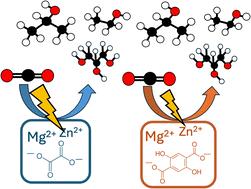使用柔性和刚性MOF电催化剂的电化学CO2还原为醇
IF 9.5
2区 材料科学
Q1 CHEMISTRY, PHYSICAL
引用次数: 0
摘要
金属有机框架(mof)是一种用途广泛的材料,具有电化学二氧化碳还原成多碳产品的巨大潜力。大多数用于电催化的mof依赖于含苯环的连接体,但其有限的电催化活性阻碍了进展。由含有脂肪链的连接物构建的柔性mof,由于其对外部刺激(如电)的响应能力,提供了另一种选择。尽管具有潜力,但很少有研究探索柔性mof用于电化学CO2还原成增值液体产品。本文利用金属核(Mg和Zn)和不同的有机连接剂:草酸和2,5-二羟基对苯二甲酸(H4DOBDC, MOF-74)合成了两种mof。电化学分析表明,草酸制备的柔性MOF具有优异的电荷输运性能,电化学阻抗谱(EIS)证实了这一点。对合成的MOFs进行了TEM、XRD、XPS、吡啶酸性等结构和化学分析。电解过程中的原位ATR-FTIR和电解后的1H NMR显示了多种碳产物的生产,包括乙醇、异丙醇和甲醇。草酸MOF比众所周知的MOF-74在- 0.19 V的RHE下表现出更好的选择性。该研究强调了柔性mof相对于传统苯基框架的优势,并为其在二氧化碳电还原液体产品中的应用铺平了道路。本文章由计算机程序翻译,如有差异,请以英文原文为准。

Electrochemical CO2 reduction to alcohols using flexible and rigid MOF electrocatalysts
Metal–organic frameworks (MOFs) are a versatile class of materials with significant potential for electrochemical CO2 reduction to multicarbon products. Most MOFs for electrocatalysis rely on benzene-ring-containing linkers, but their limited electrocatalytic activity hinders progress. Flexible MOFs, constructed from aliphatic-chain-containing linkers, offer an alternative due to their ability to respond to external stimuli such as electricity. Despite their potential, few studies have explored flexible MOFs for electrochemical CO2 reduction to value-added liquid products. This work synthesized two MOFs using metal nuclei (Mg and Zn) and distinct organic linkers: oxalic acid and 2,5-dihydroxyterephthalic acid (H4DOBDC, MOF-74). Electrochemical analysis revealed that the flexible MOF derived from oxalic acid exhibited superior charge transport properties, as confirmed by electrochemical impedance spectroscopy (EIS). Structural and chemical analyses, such as TEM, XRD, XPS, and acidity tests with pyridine, were performed using the synthesized MOFs. In situ ATR-FTIR during electrolysis and post-electrolysis using 1H NMR revealed the production of diverse carbon products, including ethanol, isopropanol, and methanol. The oxalic acid MOF demonstrated superior selectivity over well-known MOF-74 at −0.19 V vs. RHE. This study highlights the advantages of flexible MOFs over conventional benzene-based frameworks and paves the way for their application in CO2 electroreduction to liquid products.
求助全文
通过发布文献求助,成功后即可免费获取论文全文。
去求助
来源期刊

Journal of Materials Chemistry A
CHEMISTRY, PHYSICAL-ENERGY & FUELS
CiteScore
19.50
自引率
5.00%
发文量
1892
审稿时长
1.5 months
期刊介绍:
The Journal of Materials Chemistry A, B & C covers a wide range of high-quality studies in the field of materials chemistry, with each section focusing on specific applications of the materials studied. Journal of Materials Chemistry A emphasizes applications in energy and sustainability, including topics such as artificial photosynthesis, batteries, and fuel cells. Journal of Materials Chemistry B focuses on applications in biology and medicine, while Journal of Materials Chemistry C covers applications in optical, magnetic, and electronic devices. Example topic areas within the scope of Journal of Materials Chemistry A include catalysis, green/sustainable materials, sensors, and water treatment, among others.
 求助内容:
求助内容: 应助结果提醒方式:
应助结果提醒方式:


